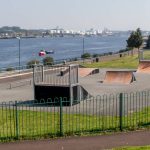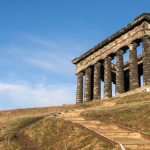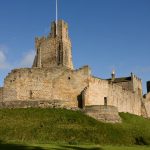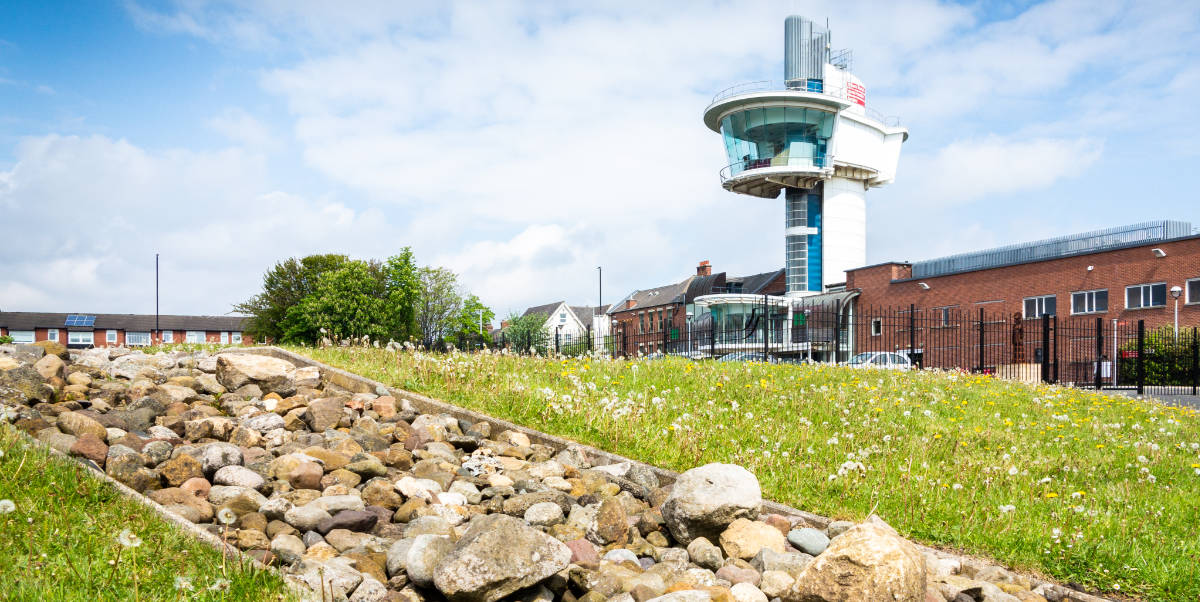
Looking for your new favourite former Roman fort site? Isn’t everybody? Wallsend, in North Tyneside, could be your new favourite staycation destination.
Famously the site of Segendunum, on the eastern end of Hadrian’s Wall, Wallsend has come a long way since the Romans first decided it looked like a tasty place for a fort. Later, the town would be a fantastic coal mining area, complete with its own shipbuilding yard. It has always been a hard life for people in the north. Up until the eighties though, if we had those two industries, we had a thriving industrial town to live in.
Let’s learn what happened between the Romans and steam power. We also want to find out from the local guides here what the best things to see and do are. Everyone loves a good attraction. We can’t wait to get stuck in.
But first – here is a little history lesson from the town that brought you, Sting. That’s right – he was baked inside a tummy right inside these figurative walls. Let’s get on with it…
Early History of Wallsend
Wallsend was once Segedunum, a roman fort with a walled area, bathhouse, and stable area. The Romans built the fort on the eastern end of Hadrian’s wall, although the wall runs southeast out of town to the mouth of the Tyne. The fort was ideal because it allowed them to control the length of the wall. The Scots notoriously raided over the border to steal cattle. There are whole areas of the Scottish Borders dedicated to the storage of stolen sheep, cows, and horses. The wall extends deep into the river. They really wanted to keep those nasty Scots out.
Before the fort, this area was arable farmland. It was home to the Brigantes tribe, one of the many tribes that occupied England around the turn of BC/AD. The Brigantes tribe had lands all the way from Yorkshire to Northumberland. There were smaller tribes around, but the Brigantes were the most prominent.
The area the Britons occupied held land banks and ditches, presumably left there by the tribe trying to protect themselves. It makes sense that the Romans chose this site for their fort. If there were lots of Brigantes in the area, this would be a point they could control the subdual of the tribe from. Also, there was no point pushing north until they had the local population under control. They did later try to build a second wall to the north, but this wall was earthen only.
Roman Fort
So, early Wallsend residents caused so much trouble that the Roman army had to build a fort to keep them in line. Farmsteads housing between 15 and 30 people would have been the main residents. Archaeologists have excavated roundhouses here, the bones of animals hunted in nearby forests, and not much else. The undeniable Roman presence shows in the artefacts dug up in the area. From coins to pottery to bathhouses to Roman walls, Wallsend has it all. Given that it is at the end of Hadrian’s Wall, we will let you guess where the name came from. ‘Segedunum’ on the other hand means ‘strong fort.’
The Romans retreated around 4AD, leaving the wall open to the immediate attack from the Picts to the north. The fort housed 600 Roman soldiers and stood for 300 years, despite their retreat. Nobody before or since has built like the Romans did. If we could re-learn their ways we would make a fortune.
Post-Roman Wallsend
Between the Romans and the Medieval period, Ida the Saxon was in charge of these parts. Recorded for posterity as Ida of Bernicia, he was the ruler of the kingdom of Bernicia. We don’t know much about Ida, except that he ruled from 547 to 559. This was the period of the biggest-guy-takes-all, and Ida liked to expand his territory. It was the people descended from Ida who would later become the Kinds of Northumbria, ultimately founding it. Before then, it was all Pictish land.
He lived in Bamburgh castle, which was then the centre of the kingdom. It is strange to think that England wasn’t always England. Anyway, Ida raided this area to the point of there was nobody living in it. Wallsend, therefore, faded off the map until much later, with King Oswald of Northumbria eventually introducing a time of peace. By the time King William invaded England, this area was already in uproar between rulers.
This area was hammered again in the Viking era. From roughly 700AD to 1000AD, the lands around the river were rife with invasions. You can learn about the Vikings in this part of the country here.
Medieval Times in North Tyneside
Unfortunately (or fortunately, depending on your viewpoint), the surveyors of the Domesday Survey didn’t come this far north. The people were making too much trouble still, so instead they built the occasional castle and once in a while had a massacre.
In 1150 the town got the holy cross on the Norman Church. Historians guess that Durham monks owned some of the lands during this period. In 1082 the Bishop of Durham gave land to the monks, upon which they built a space which would later become Durham Cathedral.
There are some horrendous witchcraft tales from the area in the 1500s, and then throughout the 16 and 1700s, the Moncaster and the Hindmarsh family reigned in Wallsend Hall. At some point, a watermill appeared on the quay. Historians say it has been turning water for power since around the 1500s or before.
Otherwise, the town is described in multiple historical accounts as a village, rather than a town, all the way up until the 1800s. The history of Wallsend Parks states there were two streets facing each other across a green, and that’s how it all began. The townsfolk used the steep hill as a natural defence, while the green between them was ideal for grazing.
Fun Facts and Wallsend Trivia
Let’s take advantage of the temporary break in our history section to learn a few Wallsend facts. Well everyone likes a bit of trivia don’t they?
- Wallsend has Latin street signs. They say it is a dead language but it ain’t dead in Wallsend. In honour of Segendunum, the town has a strong Latin knowledge, probably better than any other single town in the UK.
- There is a ghost in the old Willington Mill in town. There is even a book about it. Legend has it that ‘Kitty’ got her hair caught in the mill stones and died a grizzly death in the old mill. We can’t understand why you would go looking for ghosts in the mill when 11 major mining incidents took place here, but maybe ghosts don’t like to hang about underground.
- Campfire tales say the local Delaval family were returning from Newcastle to Seaton Delaval one night in 1570. They startled a group of witches near the ruins of the old medieval church and managed to catch one of them. The legend goes that they burned her to death on Seaton Beach. The witch muttered a spell and tried to fly away on the wooden planks at her feet, but one was wet and the water stopped her magic. The witch fell out of the sky and into the fire. Bleeding shame nobody had a camera phone in 1570, eh? We would have liked to have seen that.
- There used to be fields between Wallsend and Newcastle. Now there are only houses.
On that slightly sad note, let’s ignore the ever-spreading nature of urbanisation by occupying our minds with a little more history.
The Industrial Revolution in Tyne & Wear
There was an all-out scandal in Wallsend in 1807 when the Bishop of Durham informed the town that the wedding ceremonies performed in the school room of the town were illegal. The local Church of St Peter appeared almost overnight to rectify the situation. Children were baptised by the dozen.
In 1825 Wallsend was a pleasant village. By then, Wallsend coal carried a stamp of high quality. Coal mining was a big profession in the 1700s and on into the early 20th century here. Towards the end of the 19th century, it began to see replacement from an emerging shipbuilding industry. By 1781 there were 7 main pits around town. William Russell was one of the big coal barons here. He owned Brancepeth Castle eventually. Buddle, the coal mining engineer who invented the Steam Elephant to transport coal, worked in his Wallsend Colliery around 1806.
The Wallsend Colliery was so world-famous that the Tsar of Russia, Nicholas I, came to England on a royal tour and toured the colliery. He famously likened it to ‘the mouth of hell’ and said none but a madman would enter it. The colliery exploded in 1799, then again in 1803, then again in 1821, and then again in 1835. The death count was 13, 13, 52 and 102. One of the last collieries in the area closed in 1969. It now lies under the Rising Sun Country Park.
Badly Needed Safety Improvements
The 1821 disaster sparked safety improvements in the shafts. Ventilation was improved, and yet the next explosion was the deadliest. It killed 102 men and boys, 11 horses, and seriously injured another 4 men. Workers described seeing a puff of wind which blew off one of their hats, and then thicker smoke coming from one of the shafts. The hewers – the ones who picked the coal out of the walls – were mostly done for the afternoon.
The younger ones would then go down into the mine and bring the hewn coal out of the earth. It was during this time that the explosion occurred. 6 hewers died, along with the rest in teens and youngsters. A rescue team immediately tried to go down but was blocked by the afterdamp.
When they returned to the surface they were nonsensical. Mr Buddle got his own team together and descended via another shaft but there was so much damage that they couldn’t reach the bodies. The next day, the bodies were excavated. The worst part of it is that many died due to the afterdamp, not the explosion.
20th Century Wallsend
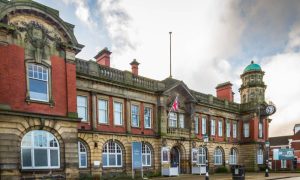
The Town Hall Which Opened In 1908
Image: larry mcguirk/Shutterstock.com
Wallsend became a municipal borough in 1901 and soon after the need for a town hall became evident. Pictured above it is still in use today and is one of the most impressive pieces of Baroque-style architecture in the vicinity. This was the first part of an age of relative prosperity for the town. This was led by shipbuilding which soon became the main industry.
The early 1900s saw some incredible ships built in Wallsend. The RMS Mauretania was a ship from Wallsend, as was the Blue Riband, the fastest liner to cross the Atlantic for 22 years straight. The RMS Carpathia came from this port, the same Carpathia which rescued the survivors of the Titanic.
Famous shipbuilding pioneer Charles Parsons even launched his Turbinia here, the first steam-powered warship. During WWII, the shipyard went into full production on warships, including the HMS Sheffield and HMS Victorious.
After WWII, the town got extra housing, which it badly needed. The Willington Quay area has evolved from a quay and unloading area to an industrial estate packed with new shops and businesses. New shops have made the town more palatable to the average visitor, and scattered memorials, old buildings, and a small village hidden inside a town, all make this place a fascinating UK town to visit.
Wallsend Today
The town is home to around 45,000 people and although many are commuters. The last shipyard closed in 2007 and today the economy is mainly driven by a range of small businesses and to a certain degree tourism given its Roman heritage. The whole region is subject to various regeneration initiatives and this bodes well for the town going forward.
Famous People from Wallsend
There have been famous people coming out of Wallsend ever since it was big enough to emit people. Here are some of our favourite famous Wallsend residents to brighten up your day:
- Sting the iconic singer and former member of the Police. So famous he only needs one name.
- John Buddie, a famous Industrial Era mining engineer, invented some things here to make the mines safer, including a lamp without an exposed flame.
- Poet Linda France is from here.
- Colin McNaughton the children’s author is from here.
- Actor Danny Murphy is a Wallsend man.
- Dave Johns, from I, Daniel Blake, is a Wallsend man.
There are also loads of footballers. A local boys club led to several footballers over the years. These include Tom Brooks, John Carruthers, Lee Clark, Mark Davis, Norman Gall, Ray Henderson, and David Lawson.
Best Attractions in Wallsend
If you are checking out northern towns for your next family holiday, then Wallsend could be for you. The attractions here are both fun and educational, and you might even learn some Latin while you are here. Here are the top things to see and do in Wallsend to prepare you.
Historic Sites
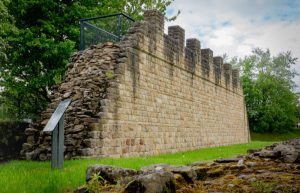
Segedunum Roman Fort is a must-visit if in Wallsend
Image: larry mcguirk/Shutterstock.com
Segedunum Fort is one place that deserves a visit. As well as the various excavations and reconstructions the site has a very impressive interactive museum. Best of all though is the viewing tower which gives stunning views of the surrounding countryside. It’s 35 meters tall so probably not the best option if you don’t like heights though. Allow a couple of hours plus to see everything.
If you like historic buildings and architecture there are in total 26 listed buildings in the NE28 area. Check out St Peter’s Church & St Luke’s Church. Both have congregations and often have events. You can even grab a swift drink in the Coach & Horses Public House and pass it off as a cultural experience.
Nearby Landmarks
You can’t come to this part of the country if you don’t come and see Hadrian’s Wall. It’s mandatory. It’s also free if you go to the right parts of it. The wall stretches an epic 73 miles from coast to coast. All along the length of it, you can find cavalry garrisons, barracks, stables, and even the odd guard house or villa. It is the visible map of where the Romans called it a day. The north was too wild for them…
However, if you’ve had your fill of all things Latin, head north to the Stephenson Steam Railway. Here you can see ‘Billy’ – the world’s third-oldest surviving steam locomotive built in 1816! You cant have a ride on him but there are other working attractions and some fine examples of early electric and diesel engines too.
Outdoor Attractions
Wallsend has play parks and facilities scattered throughout the town. There are three main public parks, all run by the same body. These include woodland areas, a picnic area or six, play park equipment, wildlife habitats, and even a café. Learn more at Wallsend Parks.
Football
If you are a football fan then you need to pay a visit to their famous club. Wallsend Boys Club has been on the go since 1904 and has produced numerous international footballers over the years. Players who were once part of the club include England Internationals Alan Shearer, Michael Carrick & Peter Beardsley. That though is just scratching the surface and you can see a more detailed list here.
The team currently plays in the Northern Football Alliance Division One which is pretty much grassroots football being level eleven on the football pyramid. However, given their penchant for producing future stars taking in a game is a must.
Golf
There is a full 18-hole golf club in Wallsend and what else would you call it except Centurion Park, cause of the Romans, get it? This is a nice course with all you need to challenge yourself. They also have a gorgeous clubhouse which serves excellent food.
Recreation
There are two main places adults can have some wholesome fun in town. Head to the Odeon Silverlink Cinema. It has all the latest releases and if you are a bingo that is catered for too.
Shopping and Retail
If you are looking for good shops you have two choices. You can shop locally at either the Forum Shopping Centre or the Silverlink Shopping Park. Alternatively, head into the city for the day as there is a good range of independent shops to enjoy.
Where to Eat and Drink
If you want somewhere classy to have a tipple, All Fur Coat serves drinks until late in the evening. You can opt for a traditional English pub if you’d like a good pint. We suggest the Queen’s Head. If you like Italian food, Sopranos has a great name and a great menu. Greek Maniacs and Thai Chang both get a special mention for being delicious.
What to do with Kids in Wallsend?
Take the kids north of town to the Round the Twist amusement centre. It has soft play and adventure play for slightly older kids. There is the Fun Shack closer to town and the New Adventureland’s Soft Play, too.
Other Nearby Notable Attractions
Wallsend makes a great staycation base and should you decide to stay a few days then have a look at our other guides below as there are some great places to visit including…
- Washington the Tyne and Wear version
- Tynemouth for a lovely seaside experience
- Or you can head to Whitley Bay and enjoy the aquarium or ice rink.
How to Get to Wallsend
When you want to go to Wallsend, it’s not just as easy as following the wall until the end. You need directions. We are probably not the people to give them to you. Nevertheless, we prevail.
By Road
Follow the A1058 from Newcastle northeast towards the coast. Three miles out of the town centre you will hit Wallsend. Or Narnia. Maybe Narnia.
By Rail
You don’t need a real train, just get the Metro from Newcastle. Wallsend is on the line.
By Air
Your nearest airport is Newcastle International.
By Sea
Your nearest port is the Port of Tyne.
Got Five More Minutes?
If you enjoyed this travel guide, you will enjoy some of our other work. Using our guides you can travel all over the UK, from the wilds of Scotland to the slightly wilder wilds of Wales. If you don’t like to travel, head to our home page as we cover a whole gambit of things.

